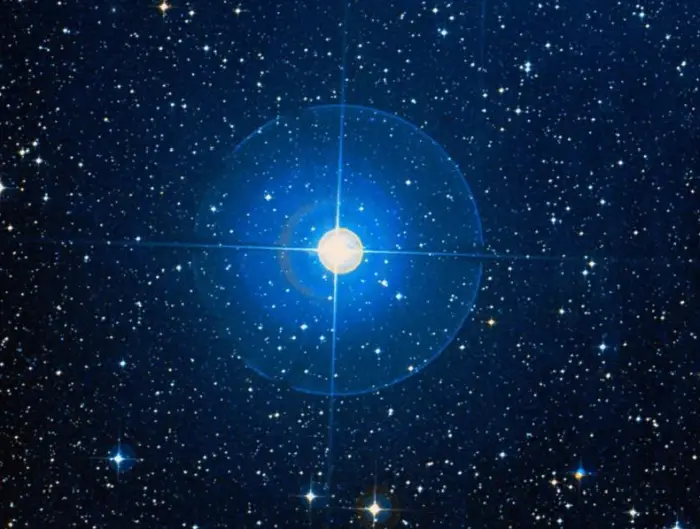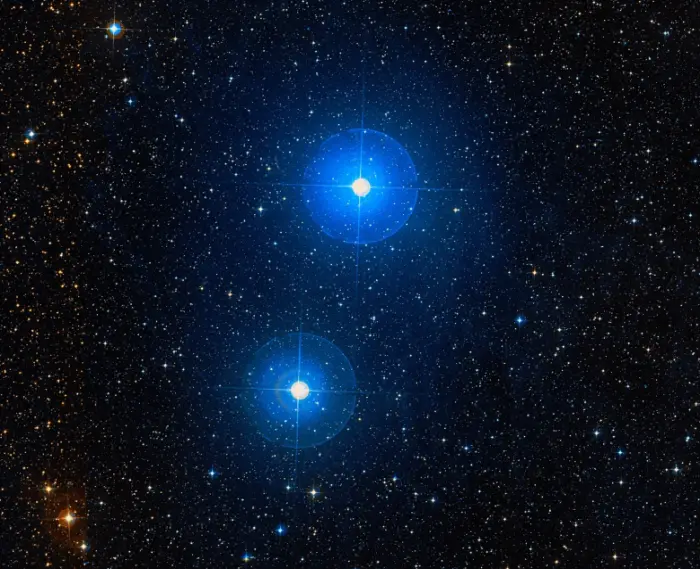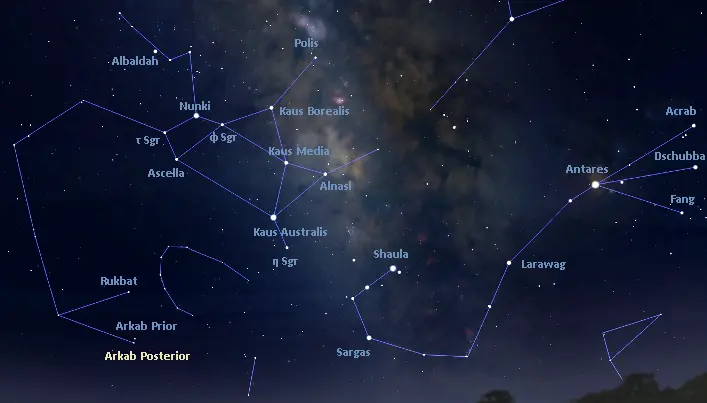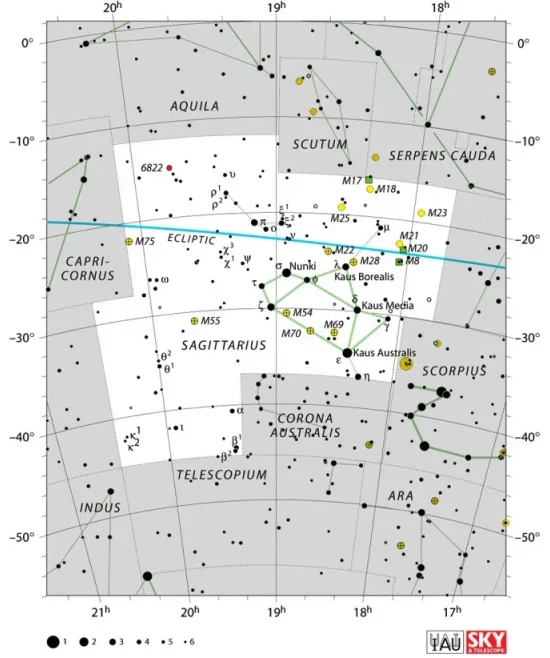Arkab Posterior, Beta2 Sagittarii (β2 Sgr), is an F-type main sequence star located 134 light-years away in the southern constellation of Sagittarius. With an apparent magnitude of 4.29, it is visible to the unaided eye. The star appears in the celestial Archer’s foot along with its slightly brighter neighbour Arkab Prior (Beta1 Sgr).
Star system
Beta2 Sagittarii is believed to be an astrometric binary system. Only one of the two components is visible. The primary component, Beta2 Sagittarii A, is a white main sequence star of the spectral type F2/3 V. It is formally named Arkab Posterior. The star has a mass of 1.43 solar masses and an estimated age of 933 million years. With an effective temperature of 7,035 K, it shines with 20 solar luminosities. Some sources classify it as a giant star of the spectral type F2 III.
Arkab Posterior is a very fast spinner. It has a projected rotational velocity of 155 km/s. As a result of its fast rotation, the star has an oblate shape. It is flattened at the poles and has an equatorial bulge. Its equatorial radius is 22 percent larger than its polar radius.
The parameters of the companion, Beta2 Sagittarii B, are unknown. The invisible star’s presence is inferred only from the primary component seemingly wobbling around a point in space, which is presumably the system’s common centre of mass. The companion may be a very faint star or possibly a neutron star.

Arkab Posterior (Beta² Sagittarii), image credit: ESO/Digitized Sky Survey 2 (CC BY 4.0)
Facts
Arkab Posterior shares the Bayer designation Beta Sagittarii with the slightly brighter Arkab Prior (Beta1 Sgr). The two star systems appear as a visual binary star but are not physically related. Arkab Prior is a younger and much more massive star that lies approximately 310 light-years away. The star systems are separated by 0.36 degrees in the sky.
Even though they were assigned the Greek letter Beta by German astronomer Johann Bayer in the early 17th century, Arkab Prior and Arkab Posterior are not among the brightest stars in Sagittarius. Rukbat, which was given the Bayer designation Alpha Sagittarii, is only the 16th brightest star in the constellation and has a similar visual brightness as the two Arkabs. Meanwhile, the constellation’s brightest stars, Kaus Australis and Nunki, were given the Greek letters Epsilon and Sigma. The reason for this is uncertain, but it is possible that Bayer never observed the two southern stars in the Archer’s foot directly.
In old Arabic astronomy, Arkab Prior, Arkab Posterior and Rukbat were called Al Suradain, the desert birds.

Arkab Prior and Arkab Posterior, image credit: ESO/Digitized Sky Survey 2 (CC BY 4.0)
Name
The name Arkab Posterior (pronunciation: /ˈɑːrkæb pɒˈstɪəriər/) comes from the Arabic Al ‘Urkub, meaning “Achilles tendon” and the Latin word for “rear” (posterior). The International Astronomical Union’s (IAU) Working Group on Star Names (WGSN) approved the name on October 5, 2016.
In traditional Chinese astronomy, Arkab Posterior was known as 天淵一 (Tiān Yuān yī), the First Star of Celestial Spring. Celestial Spring was an asterism that represented a pond in the sky. It was formed by Beta2 Sagittarii with Beta1 Sagittarii (Arkab Prior) and Rukbat (Alpha Sagittarii). The asterism was part of the larger Dipper mansion, one of the mansions of the Black Tortoise.
Location
Arkab Posterior and Arkab Prior appear in the southernmost portion of the constellation Sagittarius, near the border with Telescopium and Corona Australis. The two inconspicuous stars lie south of the constellation figure of the Southern Crown. They can be found using the stars of the Teapot, a bright asterism that dominates the Archer constellation. A line drawn from Alnasl (Gamma2 Sagittarii), the star that marks the head of the Archer’s arrow and the spout of the Teapot, through Kaus Australis (Epsilon Sagittarii) in the Archer’s bow leads to the two star systems designated Beta Sagittarii. Arkab Posterior is the southeastern of the pair.
At declination -44° 48’, Arkab Posterior is best seen from the southern hemisphere. It never rises for observers north of the latitude 45° N and only appears very low above the horizon for observers in the mid-northern latitudes.

Arkab Posterior location, image: Stellarium
Constellation
Arkab Posterior is located in the constellation Sagittarius. The Archer is one of the 48 Greek constellations, catalogued by the Greco-Roman astronomer Claudius Ptolemy of Alexandria in his Almagest in the 2nd century AD. In Greek mythology, it is associated with a centaur (possibly Chiron) and with the satyr Crotus, companion to the Muses, credited for the invention of archery and placed in the sky by Zeus.
Sagittarius is the 15th largest of the 88 constellations, stretching across an area of 867 square degrees south of the celestial equator. Like all zodiac constellations, it lies on the ecliptic, the Sun’s apparent path across the sky.
Sagittarius is one of the most distinctive southern constellations. Its eight bright stars form the Teapot, a prominent asterism located next to the rich field of the Milky Way. The asterism can be used to find many bright star clusters and nebulae that appear in this region of the sky.
Kaus Australis (Epsilon Sagittarii), the brightest star in Sagittarius, is a hot blue subgiant star that shines at magnitude 1.85 from a distance of 143 light-years. The fast-spinning star forms the Archer’s bow with its northern neighbours, the orange giants Kaus Media (Delta Sagittarii) and Kaus Borealis (Lambda Sagittarii).
Other bright stars in Sagittarius include the hot blue main sequence star Nunki (Sigma Sagittarii), the triple star systems Zeta Sagittarii (Ascella) and Nu1 Sagittarii (Ainalrami), the K-type giants Alnasl (Gamma2 Sagittarii) and Tau Sagittarii, the hot blue supergiant Polis (Mu Sagittarii), the white subgiant Albaldah (Pi Sagittarii), and the blue main sequence star Rukbat (Alpha Sagittarii).
Sagittarius is also home to the red supergiants VX Sagittarii and KW Sagittarii, both among the largest stars known, the luminous blue variable nicknamed the Pistol Star, the Wolf-Rayet star WR 102ka (the Peony Star), the Pinwheel Star (WR 104), the born-again star V4334 Sagittarii (Sakurai’s Object), and the nearby red dwarf Ross 154.

Sagittarius constellation map by IAU and Sky&Telescope magazine (Roger Sinnott & Rick Fienberg) (CC BY 3.0)
Bright deep sky objects in Sagittarius include the Lagoon Nebula (Messier 8), the Omega Nebula (Swan Nebula, Messier 17), the Trifid Nebula (Messier 20), the open clusters Messier 18, Messier 23 and Messier 25, and the globular clusters Messier 28, Messier 55, Messier 70 and Messier 75. These star clusters and nebulae can be spotted in binoculars or a small telescope.
Sagittarius also contains the planetary nebulae NGC 6537 (the Red Spider Nebula), M1-42 (the Eye of Sauron Nebula), NGC 6445 (the Box Nebula), and NGC 6818 (the Little Gem Nebula), the star-forming emission nebula NGC 6559 (the Chinese Dragon Nebula), and the Large and Small Sagittarius Star Clouds.
Sagittarius hosts the Milky Way’s central supermassive black hole, Sagittarius A* and the massive star clusters known as the Arches Cluster and the Quintuplet Cluster near the Milky Way’s centre. Other notable deep sky objects in the constellation include the globular clusters NGC 6544, NGC 6638 and the Chandelier Cluster (NGC 6723), the Sagittarius Dwarf Elliptical Galaxy, and Barnard’s Galaxy (NGC 6822).
The best time of the year to see the stars and deep sky objects in Sagittarius is during the month of August, when the constellation appears higher above the horizon around 9 pm. The entire constellation is visible from locations south of the latitude 55° S.
The 10 brightest stars in Sagittarius are Kaus Australis (Epsilon Sgr, mag. 1.85), Nunki (Sigma Sgr, mag. 2.05), Ascella (Zeta Sgr, mag. 2.59), Kaus Media (Delta Sgr, mag. 2.70), Kaus Borealis (Lambda Sgr, mag. 2.82), Albaldah (Pi Sgr, mag. 2.89), Alnasl (Gamma² Sgr, mag. 2.98), Eta Sagittarii (mag. 3.11), Phi Sagittarii (mag. 3.17), and Tau Sagittarii (mag. 3.326).
Arkab Posterior – Beta2 Sagittarii
| Spectral class | F2/3 V |
| U-B colour index | +0.07 |
| B-V colour index | +0.34 |
| Apparent magnitude | +4.29 |
| Absolute magnitude | +1.20 |
| Distance | 134 ± 1 light-years (41.1 ± 0.3 parsecs) |
| Parallax | 23.3612 ± 0.2744 mas |
| Radial velocity | +11.50 ± 1.00 km/s |
| Proper motion | RA: + 93.218 ± 0.285 mas/yr |
| Dec.: – 53.775 ± 0.210 mas/yr | |
| Mass | 1.43 M☉ |
| Luminosity | 20 L☉ |
| Temperature | 7,035 ± 239 K |
| Metallicity | -0.54 dex |
| Age | 933 million years |
| Rotational velocity | 155 km/s |
| Surface gravity | 3.57 cgs |
| Constellation | Sagittarius |
| Right ascension | 19h 23m 13.1375641478s |
| Declination | −44° 47′ 59.203680325″ |
| Names and designations | Arkab Posterior, Beta2 Sagittarii, Beta2 Sgr, β2 Sagittarii, β2 Sgr, HD 181623, HR 7343, HIP 95294, SAO 229654, CD−45°13171, CPD-45 9701, CPC 0 18135, GC 26718, GCRV 11819, PPM 325051, PLX 4528.00, SKY# 36053, GSC 07943-02106, GEN# +1.00181623, AKARI-IRC-V1 J1923132-444759, ROT 2778, IRAS 19195-4453, 2MASS J19231312-4447591, UBV 16371, UBV M 23695, uvby98 100181623, TD1 24474, TIC 62184739, WEB 16651, TYC 7943-2106-1, Gaia DR2 6664407333373349376, Gaia DR3 6664407333374099968 |